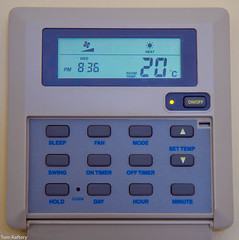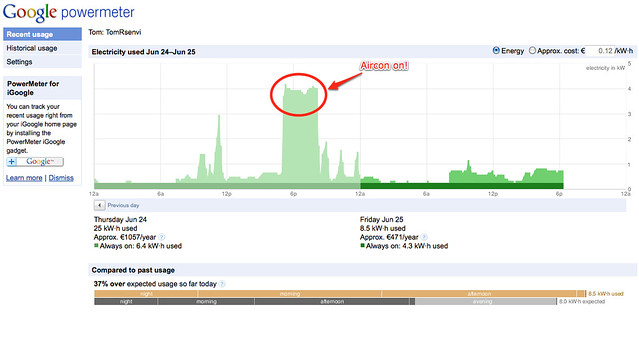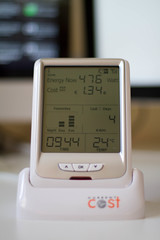The former head of Apple’s iPod Division, Tony Fadell, left Apple and founded a company making… thermostats.
No, really!
In January of 2010 Apple launched the iPad and I wrote a post here asking if Apple could make home energy management sexy. I speculated that because Apple had lodged patent applications for a Home Energy Management system, their iPad rollout would be the perfect platform to deliver it on. For whatever reason, this never came to pass.
Why is it important? Well, heating/cooling makes up around 50% of the energy used in a typical house – that’s a lot of energy/money/CO2.
Why is it necessary? Well, traditional thermostats are analagous to VCR’s in the 1980’s. Remember the flashing 00:00 you used to see on them? That was because they had an appalling user interface and almost no-one could figure out how to set the timer on them.
Well, the situation is not much better for today’s programmable thermostats. As I wrote in this post last year:
Look at the thermostat above. This is the thermostat to control the central heating/air conditioning in my home. I like to think I am reasonably technical. I have been a Windows sysadmin for a multi-national company, managing Windows, Exchange, Active Directory, ISA and SQL Servers. I edit php files regularly, I remotely manage my own CentOS server via SSH and I?ve even done quite a bit of regex scripting of .htaccess files!
But this thermostat is beyond me!
I know it has a timer, so it should be possible to set it to come on and off at pre-arranged times. Should. Getting it to do so seems to require a Stephen Hawking-like intellect. And, even if I did manage to figure it out, it is so unintuitive that the next time the clock goes forward (or back), I?d have forgotten again and would need to start over! Which begs the question, if my phone knows when to change its clock forward or back, why doesn?t the thermostat ? but I digress!
This is far too much hassle entirely. So I don?t use the timer in my thermostat. Or any of its functionality (apart from on/off). And I?m far from being alone in this.
Home energy management systems have, to-date, suffered from having appalling user interfaces. Consequently, no-one uses them.
Well, that’s about to change – as the video above demonstrates, the Nest thermostat not only has a simple iPod-like interface, it also learns your schedule and automatically adjusts the temperature settings to match them. Furthermore, when connected to your wifi, it can be adjusted remotely via phone, iPad, or browser – forget to turn off the heat/aircon when you went out shopping, or coming home early from work? No prob, open the Nest app on your phone and adjust the thermostat remotely from there!
The device also takes account of local weather conditions in its algorithms. It downloads firmware updates and it maintains a history of your use so you can see how your behaviour affected your energy use.
This does, indeed, seem to be a very cool device (pardon the pun) and one which sorely needed, which leads me to my main gripe with the Nest – it is only on sale in the US.
Here’s hoping they start selling them outside the US very soon.





